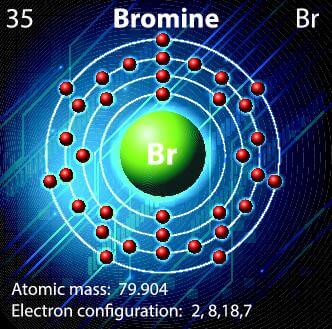27 chemical elements are considered essential for human life. Now the 28th element is added - bromine. In a new article, researchers state that bromine is the 28th essential substance for the development of tissues in all organisms, from sea creatures to humans.

27 chemical elements are considered essential for human life. Now the 28th element is added - bromine. In a new article, researchers state that bromine is the 28th essential substance for the development of tissues in all organisms, from sea creatures to humans.
In an article recently published in the scientific journal Cell, researchers from Vanderbilt University determine for the first time ever that bromine, one of the 92 common chemical elements in nature, is the 28th element in number among the essential substances for the development of life in every organism on Earth .
"Without bromine, there would be no development in the oil industry. This is our discovery," said Billy Hudson, the paper's lead author and professor of medicine. The researchers demonstrated that fruit flies died when the element bromine was removed from their diet, and survived when it was returned to their diet. This finding has important implications in the field of human diseases: "Several groups of patients demonstrated a lack of bromine," explains one of the researchers, a doctor by training. A bromine food supplement may improve the health of dialysis patients and patients dependent on intravenous nutrition, for example.
This paper is the latest in a series of groundbreaking papers by the same group at Vanderbilt University, a group that helped clarify how collagen scaffolds strengthen the membranous basis of all tissue types in the body, including the filtering units of the kidneys. The lead researcher explains that the foundations for the discovery regarding bromine were already laid 30 years ago when he himself was in medical school at the University of Kansas. Curiosity about two rare kidney diseases led, in the mid-4s, to the discovery of two previously unknown proteins that twist around each other to form the triple-helical molecule collagen XNUMX, similar to cables holding up a metal bridge. When these "cables" are damaged or damaged, diseases may develop.
In 2009, the researchers published in the prestigious scientific journal Science, about the discovery of a new sulfilimine bond between a sulfur atom and a nitrogen atom that functions as a "catch" connecting the parts of the collagen 4 molecules that make up the cell scaffolds. A damaged bond can cause the rare autoimmune disease Goodpasture's Syndrome. The discovery led to a simple question: How did this unique bond remain? In 2012, two researchers from the same university led to the discovery of the answer - the enzyme peroxidasin. As an enzyme that occurs throughout the animal kingdom, this enzyme may also play a role in the onset of disease. When the enzyme is overactive, it may lead to excessive deposition of collagen, resulting in thickening of the membranous base, which may impair kidney function, the researchers explain in an article published in the scientific journal Nature Chemical Biology. In the present study, the researchers demonstrate the unique and essential role of the bromide ion as a "cofactor" that enables the creation of the sulfilaimine bond in the enzyme structure. Hence, bromine is "an essential component for animal development and tissue structure," according to the researchers.
to the notice of the researchers
